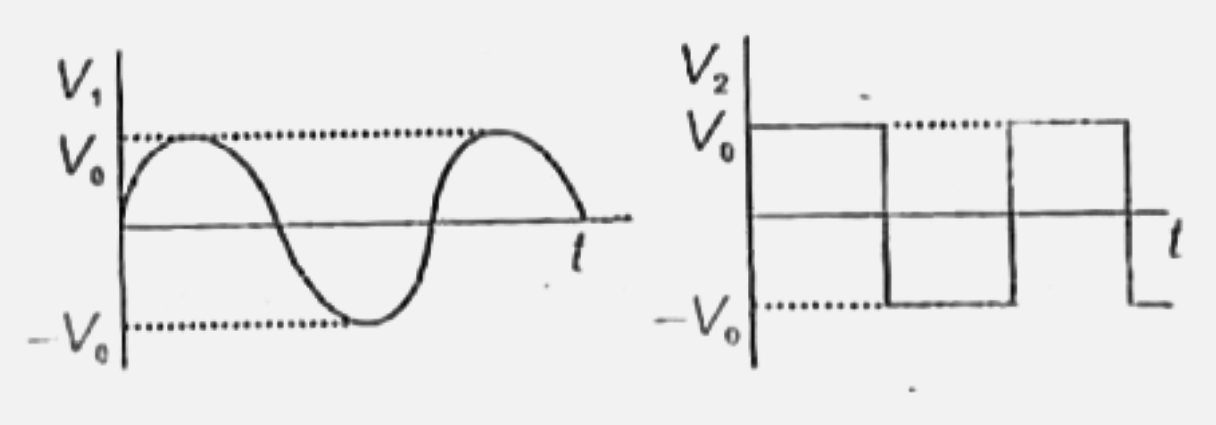The rate of heat developed in a resistor R connected to a supply of potential V is H . What will be the rate of heat developed if the potential difference is V/3 and the resistance doubled ? Solution in Bengali
In the first case ,
H'∝V2R or ,H=kV2R [ where k = constant ]
In the second case ,
H'∝(V3)22R=18=kV2R=18H
Topper's Solved these Questions
- ELECTRIC ENERGY AND POWERBOOK - CHHAYA PUBLICATIONCHAPTER - ELECTRIC ENERGY AND POWEREXERCISE - EXAMINATION ARCHIVE (WBJEE)
1 Videos
- ELECTRIC ENERGY AND POWERBOOK - CHHAYA PUBLICATIONCHAPTER - ELECTRIC ENERGY AND POWEREXERCISE - EXAMINATION ARCHIVE (JEE Main )
1 Videos
- ELECTRIC ENERGY AND POWERBOOK - CHHAYA PUBLICATIONCHAPTER - ELECTRIC ENERGY AND POWEREXERCISE - ENTRANCE CORNER (Integer answer type )
5 Videos
- DIGITAL CIRCUITS BOOK - CHHAYA PUBLICATIONCHAPTER - DIGITAL CIRCUITS EXERCISE - CBSE SCANNER
6 Videos
- ELECTRIC FIELDBOOK - CHHAYA PUBLICATIONCHAPTER - ELECTRIC FIELDEXERCISE - CBSE SCANNER
31 Videos
Similar Questions
Consider the circuit show in the figure . The value of the resistance X for which the thermal power gernerated in it is practically independent of small variation of its resistance is

View SolutionIn a large building there are 15 bulbs of 40 W , 5 bulbs of 100 W , 5 fans of 80 W and 1 kW . The voltage of the electric mains is 220 V . The minimum capacity of the main fuse of the building will be
View SolutionA power of 12 W is dissipated when two equal resistaances , joined in parallel , are connected with an electric source . What power is dissipated when they are connected in series with the same source ? (in W ) ?
View SolutionIn the circuit shown in the figure, identify the equivalent gate of the circuit and make its truth table.

View SolutionA charge q is placed at the centre of a cube of side l. What is the electric flux passing through each face of the cube?
View SolutionThe potential difference across a conductor is doubled, the rate of generation of heat will
View SolutionThe resistor of resistance ' R ' is connected to 25 V supply and heat produced in it is 25 J / sec. The value of R is
View SolutionThe sinusoidal potential difference V shown in figure applied across a resistor R produces heat at a rate W. What is the rate of heat disspation when the squre wave potential diffrence V2 as shown in figure is applied across the resistor?

View SolutionAdding a resistor at both ends of the supply of V-potentials produces heat at the rate of H in the resistor. Now double the resistor and the potential difference V/3 If done, the rate at which heat will be generated in the resistor is
View Solutionएक प्रतिरोधक में दी गयी दर H से ऊष्मा उत्पन्न होती है। जब इसे वोल्टेज V के प्रवाह से सीधा जोड़ा जाता है। अब यदि प्रतिरोधक का प्रतिरोध दो गुना कर दिया जाए और प्रवाहित वोल्टेज V/3 हो जाए तब प्रतिरोध में उत्पन्न ऊष्मा की दर होगी
View SolutionOf a resistance 'R' 25 On connecting to V supply 25 J//sec Heat is produced at the rate of The value of R is
View SolutionHeat is produced at a rate given by H in a resistor when it is connected across a supply of voltage V. If now the resistance of the resistor is doubled and the supply voltage is made V//3 then the production of heat in the resistor will be
View SolutionTwo heaters, eacch maked 1000 W, 250 V are connected in series with a 250 V supply. Assuming that their resistance remains constant, their combined rate of heating will be
View SolutionTwo heaters, each marked 1000 W, 250 V are connected in series with a 250 V supply. Assuming that their resistance remains constant, their combined rate of heating will be
View SolutionHeat is produced at a rate given by H in a resistor when it is connected across a supply of voltage V. If now the resistance of the resistor is doubled and the supply voltage is made V/3 then the rate of production of heat in the resistor will be
View Solution
